
DMT-Nexus member

Posts: 14191 Joined: 19-Feb-2008 Last visit: 22-Nov-2025 Location: Jungle
|
(edit: New analysis from 2023) Mimosa hostilis rootbark (#148 )Jan 2023  Origin: Origin: : Brazil Results:DMT 0.85% NMT 0.52% Yuremamine 0.35% DMT N-oxide 0.05% Bufotenine 0.003% Mimosa hostilis rootbark (#149)Jan 2023  Origin: Origin: : Mexico Results:DMT 0.76% NMT 0.35% Yuremamine 0.29% DMT N-Oxide 0.005% Bufotenine 0.003% Mimosa hostilis (#150)Jan 2023 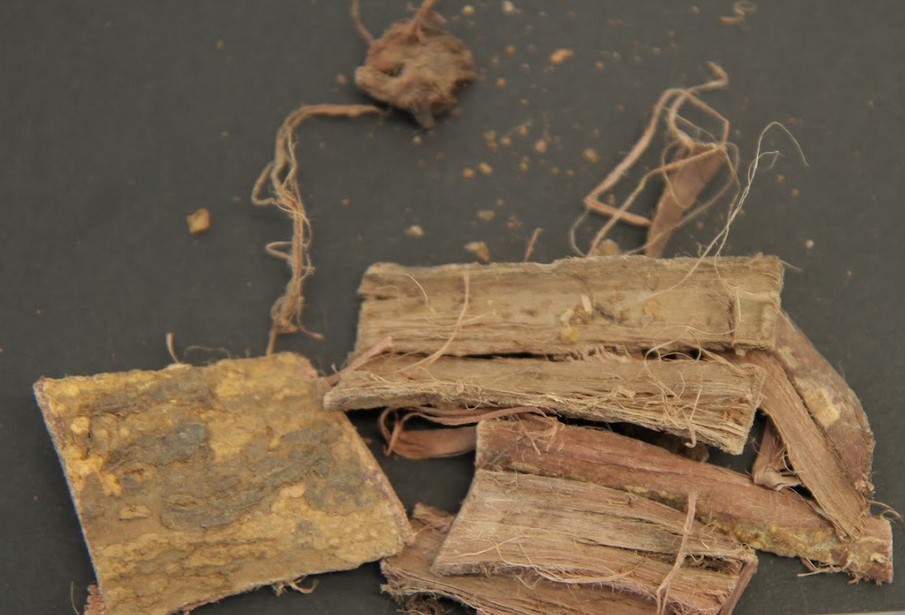 Origin: Origin: : Mexico Results:DMT 0.71% NMT 0.45% Yuremamine 0.13% DMT N-Oxide 0.005% 2-MTHBC 0.002% Bufotenine 0.001% Other excellent analysis from Brennendes Wasser:https://www.dmt-nexus.me...&m=895993#post895993https://www.dmt-nexus.me...mp;m=1177669#post1177669Older analysis from 2012 below:Mimosa tenuiflora (syn. hostilis)/Jungle Spice Analysis (last update oct 2012)Mimosa tenuiflora is one of the most important DMT-containing plants. It is used traditionally in Northeast Brazil and has been sold for years by several ethnobotanical suppliers. For these reasons, it has been the focus of considerable research by Nexians. We have tested both the crude plant preparations as well as different products extracted using a variety of different methods.
MethodologyAt first I started with TLC vs some reference standards, and this has eventually evolved to GC-MS and LC-MS testing of all samples
The main results are:
Orange text indicates novel research.
++++ indicates the main substance present
+++ indicates relatively high amounts present
++ indicates moderate amounts present
+ indicates small amounts present
- indicates trace amounts presentMimosa tenuiflora (whole root bark):++++ DMT +++ Yuremamine ++ Catechol, homocatechol, resorcinol, etc. (possibly breakdown products of yuremamine and/or lignin) * (these have been tentatively identified by mass spectra but not confirmed with a reference standard) + NMT + 2-MTHBC - Hordenine, N-Methyl-Phenetylamine, Dimethyl-Phenetylamine, N-Formyl-NMT, 1,2-Dimethyl-Tetrahydro-Beta-Carboline * (these last 5 trace alkaloids have been tentatively identified by mass spectra but not confirmed with a reference standard) DMT (extracted with naphtha, xylene + FASA or limonene + FASI):++++ DMT + NMT+ 2-MTHBCDMT (extracted with xylene + evaporated or limonene/xylene/toluene + aqueous
saltings):
++++DMT
+NMT
+2MTHBC
+ 1-2-Dimethyl-Tetrahydro-Beta-Carboline.
+ 1-Methyl-Tetrahydro-Beta-Carboline
- Hordenine, N-Methyl-Phenetylamine, Dimethyl-Phenetylamine, N-Formyl-NMT * (these last 6 trace alkaloids have been tentatively identified by mass spectra but not confirmed with a reference standard)
Conclusions.These analyses confirmed that heating up or extracting Mimosa tenuiflora (and analysis by GC-MS) breaks down some of the original components found in the plant material, most notably yuremamine, which may play a role in making cold-brewed Mimosa preparations orally active without a RIMA/MAOI (Callaway 2005) When extracting with solvents that are less-selective than naphtha, we found very small amounts of two other beta carbolines that have unknown effects. It's possible that at this concentration they do not affect the experience, but they might, at these or higher concentrations. Some people believe that even in the small amounts found, these alkaloids do affect the experience but we don’t yet know if this is the result of self-suggestion or not. The few psychonautic blind tests that have been conducted do not confirm any noticeable difference in activity. To concentrate these non-DMT alkaloids, you can precipitate DMT from a solvent by the FASA/FASI method, and later wash the solvent with water and evaporate the water to retrieve the other alkaloids plus excess fumaric acid and some other plant impurities. It is important to note that we do not know if a concentration of these other alkaloids is safe or desirable for ingestion. We also have yet to confirm whether at least part of these other alkaloids are artifacts of extraction/analysis or if they are present in the plant. Identification of main substances was done with reference standards and GC/LC-MS but some of the more obscure substances present were only based on mass spectra match in database after GC-MS testing, so should not be considered an absolute proof. I post further in this thread and elsewhere in this subforum the attached mass spectra and welcome any and all peer review.
Original post from dec 2011Here's some more analysis ive been doing lately on extracts of Mimosa Hostilis This is all from A/B extraction on Mimosa hostilis using lye as a base (and limonene as solvents in most of them, except 6 and 9, which are using naphtha, and 5, using xylene) First, the samples: J - Jungle - Xylene evap and then 2x warm naphtha pulls to supposedly remove (most) DMT 1- Jungle - Xylene evap 2- FASW (Fumaric Acid Saturated Water) crude saltings from limonene pulls 3- FASI (Fumaric Acid Saturated IPA) precipitation from limonene pulls - From pulls 2,3,4, yellow 4- FASI - From pull 1, white 5- FASA (Fumaric Acid Saturated Acetone) precipitation from xylene pulls. 6- FASI - Yellow part on the bottom of FASI crystallization, due to water in IPA 7- Freebase from naphtha, white 8- Freebase from converted FASI, white 9- Freebase from naphtha, yellow. 10- Freebase from converted FASW, brown impure Now TLC plate: 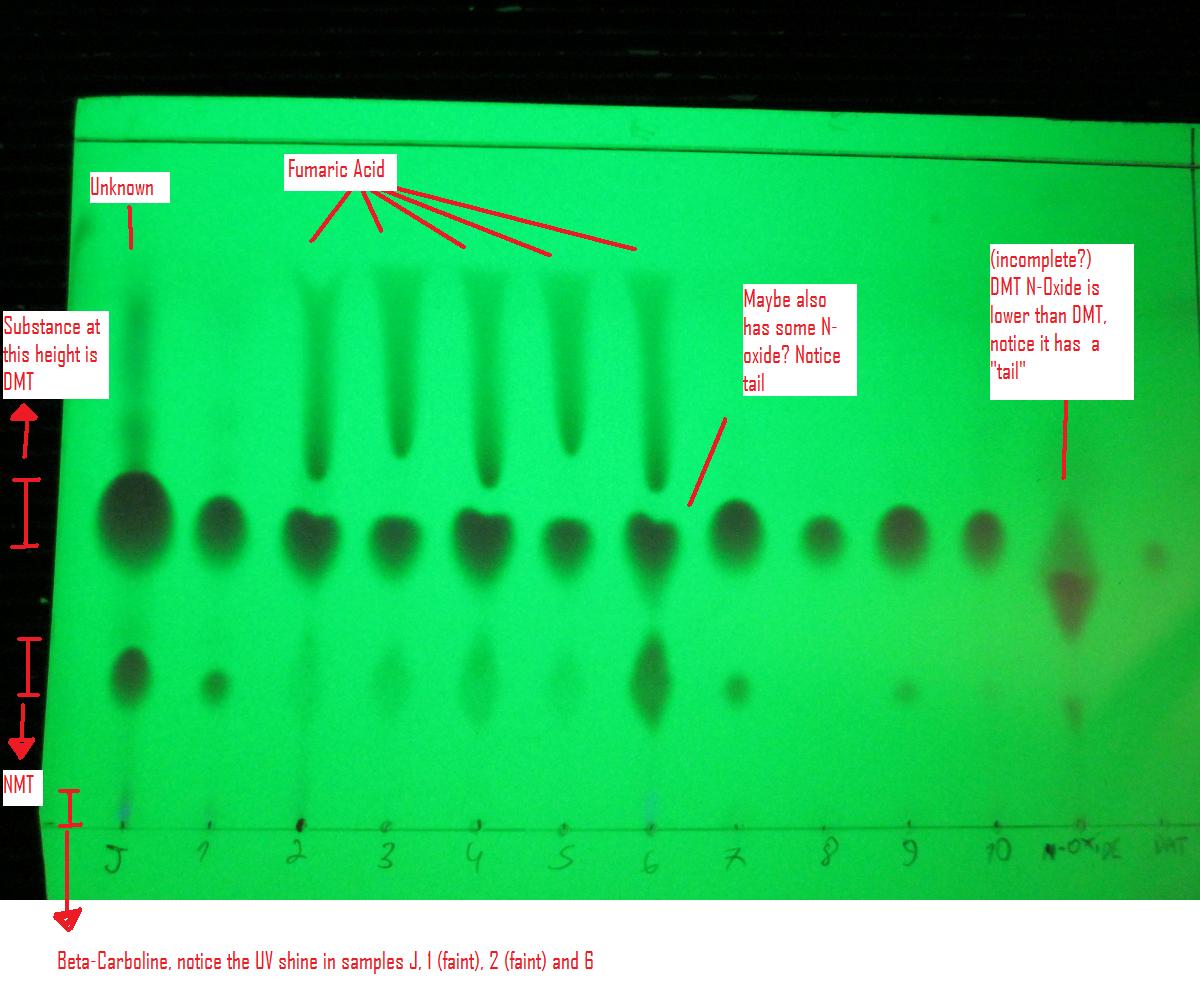 The last two columns: Second last is some attempt to make n-oxide (just added 10% hydrogen peroxide to a bit of sample 7 dissolved in methanol and used that. I think 10% is too weak to make full conversion but clearly there was some change). Last column is DMT standard. As you can see, samples 2,3,4,5 and 6 all have a top streak/spot, which is the fumaric acid. Sample J has some spots/streak at around same height but its clearly some different substance/s. Most samples, except 8, have DMT and NMT spots. Sample 8 was not done from same mimosa, was from earlier batch, so hard to make conclusions regarding apparent lack of NMT. (see later GC-MS discussion for more mistery... ) Samples J, 1, 2 and 6 show some Beta carboline, others dont see to show it (again, GC-MS will show more weirdness, stay tuned) The first funny things that show up in this plate: the supposed no-dmt jungle seems to have plenty of dmt. Also the NMT presence in nearly all samples is pretty interesting. More information below with GC-MS analysis (and NMR soon) And for those that care: This was done on silica gel 60 F254 from Merck, eluent is Methanol:Ammonium Hydroxide 100:2.5 The measured Rfs are: DMT - 0.4-0.44 NMT - 0.19-0.23 Bcarboline - 0.03 N-oxide (?) - 0.31-0.34 Next up: GC-MS of samples 1,2,4,6,7 , and NMR of samples J, 1 and 2
|
|
|
|
|

DMT-Nexus member
Posts: 681 Joined: 11-Sep-2010 Last visit: 24-Dec-2011
|
interesting, thanks for posting
|
|
|

SWIM
Posts: 1239 Joined: 08-Aug-2009 Last visit: 31-Dec-2025 Location: Nowhere, I'm not real.
|
Very cool! Q21Q21's Tek: A comprehensive guide to extracting DMTThe 2 teks use non-toxic lime and vinegar and Tek 1: d-Limonene or Xylene or Tek 2: Naptha to produce very quick high yields with the greatest of ease.I am almost never on this site anymore so I will likely not answer PMs
|
|
|

DMT-Nexus member
 
Posts: 1952 Joined: 17-Apr-2010 Last visit: 05-May-2024 Location: somewhere west of here
|
Excellent work-many thanks for your efforts and for sharing!  I am paranoid of my brain. It thinks all the time, even when I'm asleep. My thoughts assail me. Murderous lechers they are. Thought is the assassin of thought. Like a man stabbing himself with one hand while the other hand tries to stop the blade. Like an explosion that destroys the detonator. I am paranoid of my brain. It makes me unsettled and ill at ease. Makes me chase my tail, freezes my eyes and shuts me down. Watches me. Eats my head. It destroys me.
|
|
|

DMT-Nexus member

Posts: 14191 Joined: 19-Feb-2008 Last visit: 22-Nov-2025 Location: Jungle
|
1 - Jungle spice (unwashed) ExtractionA/B on ad*e*nium bark, vinegar and lye, pulled with xylene at room temperature, evaporated. TLC
Results(see picture in first post) Seemed to have small amount of some beta-carboline, DMT, NMT. PDMAB-TS turned DMT and NMT yellow, did not have apparent reaction with b-carboline.
GC-MSResults : DMT, 2MTHBC, MTHBC and another unknown possible beta-carboline (edit: dozuki in post 66 and 67 of this thread suggests its a yuremamine degradation product, but it possibly is 1,2-dimethyl-tetrahydrobetacarboline) in the respective ratio of 268: 1.9: 1.03: 1 Plus unidentified trace components at early retention times. Too weak signal to tell what it is. Raw Agilent *.MS file, plus pictures of mass spectra of the 4 substances is attached for those who want to double check the work. To open the MS file, use the program linked here or pm me for more info. Discussion and Questions: * NMT is co-chromatographing with DMT hence it doesnt appear as distinct peak specially because its small amounts (as confirmed when GC-MSing Acacia confusa) * Can all or some of these beta carbolines be artifacts from analysis, or be created in extraction conditions or be breakdown products of yuremamine? Possible ways to answer questions: Run a mass spec with NMT standard (to be done in the future), run a crude mimosa methanol soak to compare endlessness attached the following image(s):  JTIC.jpg (75kb) downloaded 3,124 time(s).
|
|
|
DMT-Nexus member

Posts: 351 Joined: 25-Jul-2009 Last visit: 25-May-2016 Location: Europe
|
Glad to see you are into analytic work - and quite actively if i may say so. This takes the whole "advanced" sections of the forum a notch up. Plus its an invaluable service to the nexus that can answer lots of "speculation" on what is what. Keep up the good work, for those that unfortunately haven't got the resources to participate.
|
|
|

Faustian Phytochem Investigator
 
Posts: 194 Joined: 31-Oct-2011 Last visit: 29-Nov-2025 Location: Oaxaca
|
Definitely interesting! In regards to the NMT spot (lower spot) are you judging this based off of Rf value? I'm really curious about this spot and the ones above in the first lane, and I'll explain a bit. If you look at the attached picture (Plate 18 ) this is a very similar extraction done 5 years ago and run in almost the identical eluent: Lane 1: full A/B extraction (hard to tell from my notes if the Organic was Naptha or Toulene Lane 2: simple MeOH extraction (RT for 2 hours) Lane 3: Same as lane 2 but added in with photoshop as this is lane 2 without Xanthydrol viz. 2nd: Pic is this same plate photographed really quick this afternoon under long wave UV (I didn't have it back then) The interesting thing here is that the lower spot B (Labeled NMT in your plate) shows up both as a Xanthydrol visualized spot in both UV and standard lighting in Lane 1, but does not appear at all in Lane 2 (MeOH extraction). Spot A is DMT and shows up in both lanes both lightings, Spot C (unknown) Shows up visualized in Lane 2, but only in UV in Lane 1. Also interesting to note, is that as the original A/B extraction sat around, one of the higher Rf spots no longer showed up on the plates (including #18, as the extraction had been done about a week before). In fact the missing spot on the plate with the higher Rf only showed up in the first 4 days of the extraction. My hypothesis was that yuremamine was being broken down by the alkali conditions and that Spot B and the disappearing spot with the higher Rf's were the degradation products of that process. I wouldn't have even really thought of it, except that you plate looks like a lot of my plate combined when using that system. As for creating the N-Oxide, a drop of 30% H2O2 applied directly to the dried and spotted sample on the plate works really well, though it still wasn't a complete reaction. The oxide spot showed a higher Rf. Dozuki attached the following image(s):  Plate18.jpg (60kb) downloaded 3,084 time(s). UV18.jpg (29kb) downloaded 3,079 time(s).
|
|
|

DMT-Nexus member

Posts: 14191 Joined: 19-Feb-2008 Last visit: 22-Nov-2025 Location: Jungle
|
Very interesting. Ok so let me get this straight, spot B, supposed NMT, did NOT appear on pure methanol soak, from the same mimosa... What reasons could there be? As for the NMT identification, it was some inference, from appearing a spot at the same height in some acacia confusa plates, as shown here: https://www.dmt-nexus.me...&m=298786#post298786 The acacia confusa was GC-MSed, and there was some NMT there, appart from some other stuff. The acacia was some simple methanol soak..... Taking this together with the fact that burnt claimed to have found NMT in mimosa, I took it as a confirmation. In any case we're looking to get some NMT standard in the near future, so this will help answering our doubts. One thing I didnt understand from what you said, though, about the dissapearing spot. Which spot was it that dissapeared? Is it one of the ones on the pic? And if both were done together, why the A/B had the supposed degradation while the methanol didnt, was the methanol freshly soaked and tested?
|
|
|

Faustian Phytochem Investigator
 
Posts: 194 Joined: 31-Oct-2011 Last visit: 29-Nov-2025 Location: Oaxaca
|
Both of these extractions were done on the same material. The MeOH extraction was done the same day as it was spotted on the plate. The disappearing spot only stayed in the original extraction solution for 4 days. It was a spot with a higher Rf than any of the spots on the on early plates. Plate 18 was run about 1 week after the initial extraction so it didn't show this high Rf spot, but shows B and C which appear to be degradation products. Under UV, D and A are both Dmt. Spot C, that shows up in both lanes, only reacts to Xanthydrol in the MeOH extraction to show a Full Spectrum (White and UV light) visible spot. I would hypothesize that Spot C, after going through the extraction procedure breaks down into a visible spot B in the extraction, and UV-visual only spot C in the extraction. I suspect that Spot B carries the indole portion of the broken down compoud as it still reacts with Xanthydrol I hypothesized that these 2 spots were yuremamine, as it is stated in the lit that it breaks down in alkaline conditions. The plates that I ran would seem to be showing this. I also ran into an inference (post from nen88  that purified yurmamine was a purplish color. This would correlate with spot E in Lane 3 (before spraying with xanthydrol) as it has a bluish color there (dilution of purple color to blue?). At the time, I didn't know this, and thought it could possibly be a tannin, however, you could watch the spot disappear as it went up the plate. I also think that spot B possibly continues to break down in solution, as it is not visible on any of my plates now (I'm using it as the control in the current plates). EDIT: It is still there, was looking at much lower dilutions.
|
|
|

DMT-Nexus member

Posts: 14191 Joined: 19-Feb-2008 Last visit: 22-Nov-2025 Location: Jungle
|
Hmmmmmm... Was your eluent also with ammonia ? So if spot B is NMT, could NMT be a breakdown product of yuremamine under alkaline conditions? Anybody else with good chemical knowledge want to chime in? If you do a new plate, can you take a picture of the UV of freshly extracted ? You are saying that spot C does not show up with UV light like you can see on the second pic ? Also, if A and D = DMT, wouldnt E = DMT too? Or is it more like only the thin blue line just on the limit/above DMT ? Or if you say its yuremamine for the blue/purple, then where is DMT there? Sorry for so many questions 
|
|
|

Faustian Phytochem Investigator
 
Posts: 194 Joined: 31-Oct-2011 Last visit: 29-Nov-2025 Location: Oaxaca
|
Yes, the eluent contained ammonia, that's why its only a half plate. endlessness wrote: So if spot B is NMT, could NMT be a breakdown product of yuremamine under alkaline conditions? Anybody else with good chemical knowledge want to chime in? I suppose there is that possibility. I suspect it to be some indole due to the Xan. reaction. I need to read the paper on the Xan. reaction again. How close were your Rfs for NMT on the Acacia vs. the Mimosa? Its hard to tell as the plates look different sizes in the pics... I may play around with them in photoshop. endlessness wrote: If you do a new plate, can you take a picture of the UV of freshly extracted ? You are saying that spot C does not show up with UV light like you can see on the second pic? Spot C in lane 2 does show up under UV, its a larger spot than the UV only spot in Lane 1 and barely fluoresces AND shows a visible Xan reaction whereas Spot C in Lane 1 shows under UV only (as a bluish UV glow; the spot is also more tight and compact). However, Spot C's shape in lane 2 does not appear to be a line like Blue Spot E. Spot C, Lane 1: UV only Viz, compact spot, Blue glow Scot C, Lane 2: UV and Full spectrum Viz, larger spread out spot, glow color undetermined as there are too many tannins Another thing with UV is that what shows up under UV will be different before and after spraying with Xan. endlessness wrote:Also, if A and D = DMT, wouldnt E = DMT too? Or is it more like only the thin blue line just on the limit/above DMT ? Or if you say its yuremamine for the blue/purple, then where is DMT there? No, E is the blue visible band that sits at the top of the DMT spot as a compacted line. The DMT shows up as the spot under the blue band, kind of like the blue band is the DMT spot's hat (or that the DMT spot is pushing it up the plate). endlessness wrote:Sorry for so many questions  It's no problem. Spot B is what originally de-railed me from doing TLC on Phalaris. Spot B does still show up in that extraction, so it doesn't keep degrading like I though, its just barely there on the Phalaris plates. It's weird too that spot B doesn't show up on the MS. It's like the mystery compound that doesn't want to show itself.
|
|
|

Faustian Phytochem Investigator
 
Posts: 194 Joined: 31-Oct-2011 Last visit: 29-Nov-2025 Location: Oaxaca
|
Okay, I just put the two images together, and the Rfs from the Acacia and Mimosa are about dead on... Also, the thing with the MeOH extraction of Mimosa is that the tannins are a real pain. Doing a Mass Spec on a(n) MeOH extraction would be interesting. The paper on Yuremamine said that it should be obvious from its structure where it breaks down in alkali conditions. If you hack off the non-ring bonds of yuremamine you get something like the attached picture. It's pretty close to a beta carboline, but not quite... This is purely speculation on my part.... Dozuki attached the following image(s):  Degrade.png (19kb) downloaded 3,009 time(s).
|
|
|

DMT-Nexus member

Posts: 14191 Joined: 19-Feb-2008 Last visit: 22-Nov-2025 Location: Jungle
|
Interesting! I've drawn this in Chemdraw and was looking at the possible fragments in a MS, and it did not seem like something that appeared in the GC-MS, but I dont have enough experience/chem knowledge to say that for sure. The calculated molecular weight is 244.16. The structure-to-name conversion says this molecule would be called (R)-9-(2-(dimethylamino)ethyl)-2,3-dihydro-1H-pyrrolo[1,2-a]indol-2-ol Nothing came up in google search. I'm attaching the NMR 1H prediction, once the results of jungle NMR come, we can see if we we see anything similar.
|
|
|

DMT-Nexus member

Posts: 14191 Joined: 19-Feb-2008 Last visit: 22-Nov-2025 Location: Jungle
|
2- FASW   Extraction ExtractionA/B on ad*e*nium bark, vinegar and lye, pulled with limonene at room temperature, salted with FASW, evaporated with low heat
TLC
ResultsSeemed to have small amount of some beta-carboline, DMT, NMT (and fumaric acid) PDMAB-TS turned DMT and NMT yellow, did not have apparent reaction with b-carboline, neither with fumaric acid
GC-MS Results Results : DMT, 2MTHBC, MTHBC and another mistery probable beta-carboline (edit: dozuki in post 66 and 67 of this thread suggests its a yuremamine degradation product) in the respective ratio of 225: 3: 0.7: 0.5 Plus unidentified insignificant trace components with too weak signal to tell what they are. There is also a very small amount of what seems very likely to be dmt n-oxide (mass weight 204, similar spectra to DMT, eluted just after dmt, same as what is found when adding h2o2 to dmt and analyzing...) Raw Agilent *.MS file, plus pictures of mass spectra of the 3 beta-carbolines is attached for those who want to double check the work. Discussion and Questions: * FASW results are very similar alkaloid-wise than jungle spice. * Again, NMT is co-chromatographing with DMT, in lower amounts in this system/column it doesnt appear as distinct peak. Check my post in page 2 of this thread * Can beta-carbolines be artifact from analysis, or be created in extraction conditions or be breakdown products of yuremamine? Possible ways to answer questions: NMR results, Run a mass spec with NMT standard (to be done in the future), run a crude mimosa methanol soak to compare, LC-MS to compare.
|
|
|

DMT-Nexus member

Posts: 14191 Joined: 19-Feb-2008 Last visit: 22-Nov-2025 Location: Jungle
|
3- FASI yellow 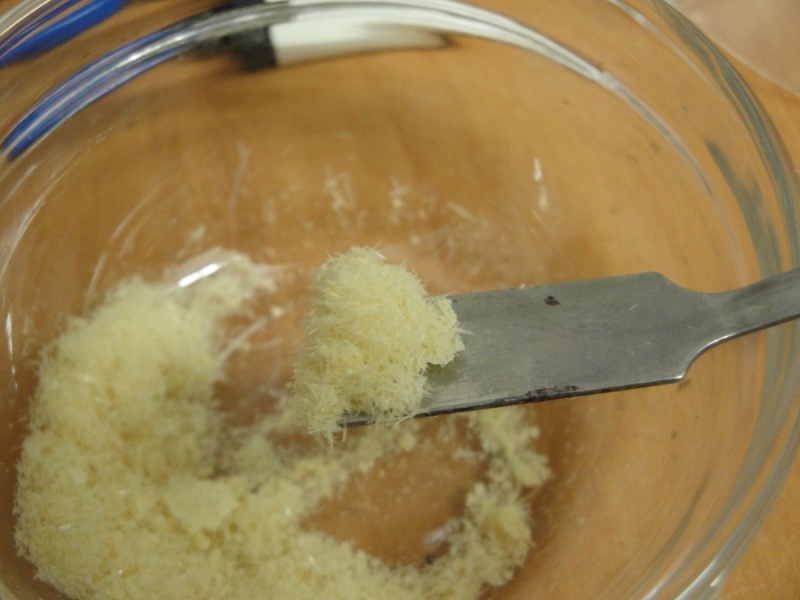  Extraction ExtractionA/B on ad*e*nium bark, vinegar and lye, pulled with limonene at room temperature, salted with FASI. This was the 2, 3rd and 4th pulls from limo. Scrapped together they were yellow.
TLC
ResultsSeemed to have DMT, NMT (and fumaric acid) PDMAB-TS turned DMT and NMT yellow, did not have apparent reaction fumaric acid
GC-MSResults : Not done yet, will try to next week or two. Same for Uv-Vis Photospec.
|
|
|

DMT-Nexus member

Posts: 14191 Joined: 19-Feb-2008 Last visit: 22-Nov-2025 Location: Jungle
|
4 FASI white  Extraction ExtractionA/B on ad*e*nium bark, vinegar and lye, pulled with limonene at room temperature, salted with FASI. Only retrieved the FASI that were on the sides of the container, white crystals, not the yellow accumulation on the bottom. Only from first pull.
TLC
ResultsSeemed to have DMT, NMT (and fumaric acid) PDMAB-TS turned DMT and NMT yellow, did not have apparent reaction fumaric acid
GC-MS Results Results : DMT, 2MTHBC, and limonene traces in the respective ratio of 319: 2.6: 0.1 Plus one unidentified insignificant trace component with too weak signal to tell what it is. Raw Agilent *.MS file, plus pictures of mass spectra of the beta carb and limo is attached for those who want to double check the work. Discussion and Questions: * FASI precipitation yields only one beta-carboline trace, which does not seem to shine on UV ? This is interesting that there is another betacarboline or two that have not been described before in mimosa analysis. Its also interesting that they do not precipitate with FASI but do migrate to FASW and are present with xylene evap/jungle. * Again, NMT is co-chromatographing with DMT and hence doesnt appear as distinct peak, check post in page 2 * Can these b-carbolines be active? Notice they are only in very trace amounts, here 2MTHBC is in less than 1%. Possible ways to answer questions: NMR, maybe some liquid chromatography. Will see if my friend can NMR it... liquid chrom, only next year.. Concentrating these b-carbolines with column and bioassaying would be interesting.
|
|
|

DMT-Nexus member

Posts: 14191 Joined: 19-Feb-2008 Last visit: 22-Nov-2025 Location: Jungle
|
6- FASI - Yellow container-bottom accumulation   Extraction ExtractionA/B on ad*e*nium bark, vinegar and lye, pulled with limonene at room temperature, salted with FASI. Only the yellow part that accumulated on the bottom of the container on the first pull (Same as 4- FASI white) was separated and analysed. This bottom yellow accumulation is due to small water content of IPA or that was left over from washing limonene before. As soon as one adds the FASI, if one sees drops/goo on the bottom, decant and let FASI fumarates crystallize slowly, this will separate.
TLC
ResultsSeemed to have small amount of some beta-carboline, DMT, NMT (and fumaric acid) PDMAB-TS turned DMT and NMT yellow, did not have apparent reaction with b-carboline, neither with fumaric acid
GC-MS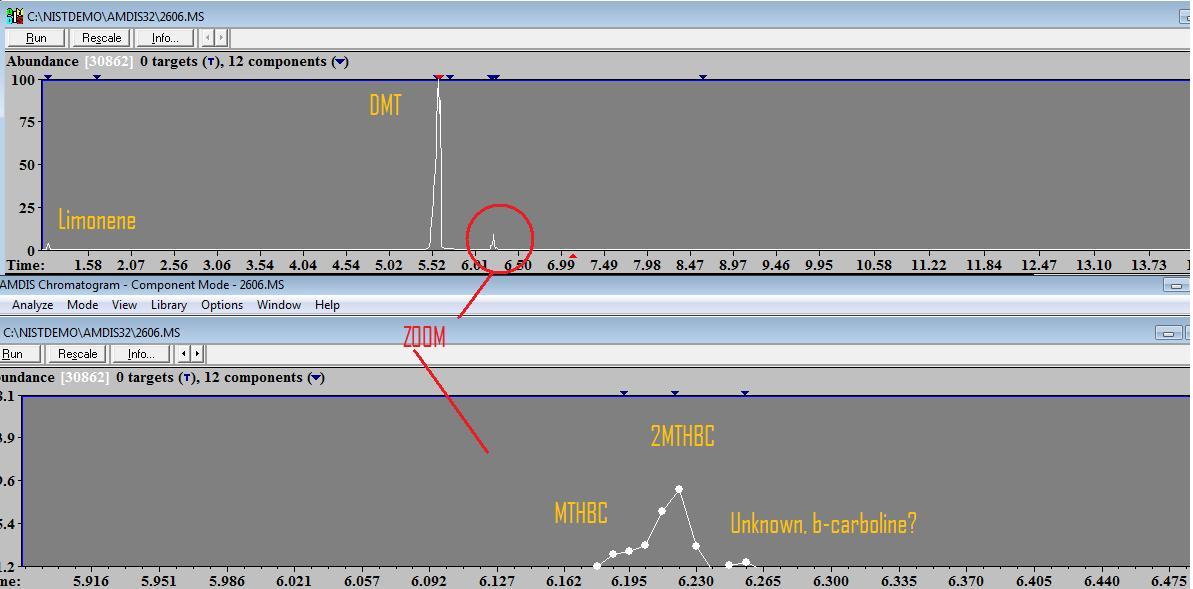 Results Results : DMT, 2MTHBC, MTHBC, another possible b carboline (edit: dozuki in post 66 and 67 of this thread suggests its a yuremamine degradation product) and limonene in the respective ratio of 103: 10: 2.4: 1: 6.8 Plus unidentified insignificant trace components with too weak signal to tell what they are. Raw Agilent *.MS file is attached for those who want to double check the work. Discussion and Questions: * FASI "goo" that goes to bottom of container when using wet IPA has very similar alkaloid profile to FASW and jungle results are very similar alkaloid-wise than jungle spice. It is interesting to note that, as predicted, this water on the bottom of the container has pulled the other beta-carbolines that do not precipitate with propper dry FASI. A potential idea to further concentrate these other beta carbolines would be doing FASI and after retrieving crystals, washing with water to retrieve other b-carbolines. * The goo had clearly much more limonene quantity than the clean FASI. While this wet yellow FASI one has nearly 7% of dmt weight in limonene (it was clearly wet as I took it to analyse), while the other clean FASI had 0.03% of limo weight. A little cold/dry acetone or IPA washing on wet orange-smelling fumarates would go a long way if you want to remove limonene leftovers. * Again, where is that NMT that appears on the TLC (it should appear just after DMT, at around 5.7min)?
|
|
|
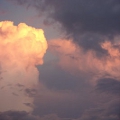
Cloud Whisperer

Posts: 1953 Joined: 05-Jan-2009 Last visit: 22-Jan-2020 Location: Amongst the clouds
|
Endlessness Wow nice work bro, im left completely speechless... Much Peace and Understanding
|
|
|

Faustian Phytochem Investigator
 
Posts: 194 Joined: 31-Oct-2011 Last visit: 29-Nov-2025 Location: Oaxaca
|
endlessness wrote:* Where the hell is that NMT that appears on the TLC (it should appear just after DMT, at around 5.7min)? I would suspect that it doesn't show up in GC?? Would have no Idea why. endlessness wrote:* Can all or some of these beta carbolines be artifacts from analysis, or be created in extraction conditions or be breakdown products of yuremamine? I would suspect that the first two would be more plausible. If using acetonitrile in the GC there is the *possibility* that DMT is condensing into 2MTHBC similarly to Shulgin finding this as an artifact of the synthesis of DMT. While reading about Xanthydrol I ran across a reference that serotonin is condensed into 6-Hydroxytetrahydroharman via formaldehyde (I imagine this would be a similar reaction with acetonitrile?). As for yurmamine degradation products (YDP) condensing to BCs, I would think that it would depend on the structure of these YDPs and I wouldn't rule out that possibility completely. endlessness wrote:* FASI precipitation yields only one beta-carboline trace, which does not seem to shine on UV ? Try running a plate in an acidic eluent like Butanol:AcOH:H2O (12:3:5). BCs and Tryptamines fluoresce better under acidic environs. endlessness wrote:* Can these b-carbolines be active? Notice they are only in very trace amounts, here 2MTHBC is in less than 1%. I read somewhere that 2Me6MeOTHBC was active, but didn't give too much credit to the source as it was just stated out of nowhere - I think the jury is still out on this one.
|
|
|

DMT-Nexus member

Posts: 14191 Joined: 19-Feb-2008 Last visit: 22-Nov-2025 Location: Jungle
|
Hmmmm, there was no acetonitrile used. In any case, every DMT I tested had at least DMT and 2MTHBC. Even acacia confusa showed it, and it was pure methanol soak, no extraction, and AFAIK it had not yet been shown in acacia confusa? It was also there in big medicine and aq1 phalaris but not in yugo red (Which only showed traces of dmt)
And the MTHBC only shown in evaporation or acqueous saltings of mimosa, not in fumaric precipitation, so it is probably not an analysis artefact, though maybe an extraction one. A simple mimosa methanol soak and gc-ms would be interesting to do.... also Im wondering about nmr results, hopefully this coming week.
Oh a bit more info on other samples:
Sample - UV-Vis spectrophotometry purity results
7 (Freebase from naphtha, off-white from freeze precip) - 89%
8 (Freebase from converted FASI, white (over year and a half old) - 87%
9 (Freebase from naphtha, yellow from evap) - 85%
10 (Freebase from converted FASW, brown impure) - 70%
|